Process Improvement Plans: A Step-by-Step Guide
Gain an understanding of the essential steps and strategies necessary to create and execute successful process improvement plans.
Last Updated
April 20 2023
Looking to streamline your workflows, remove inefficiencies, and supercharge your business operations? It all starts with a process improvement plan. In this article, we’ll explain what a process improvement plan is, why they’re important, and what goes into creating an effective plan that guarantees a positive outcome for your business.

What is a Process Improvement Plan?
A process improvement plan (PIP) is a strategic document detailing everything you’ll need to know and do as you make foundational changes to your workflows and processes.
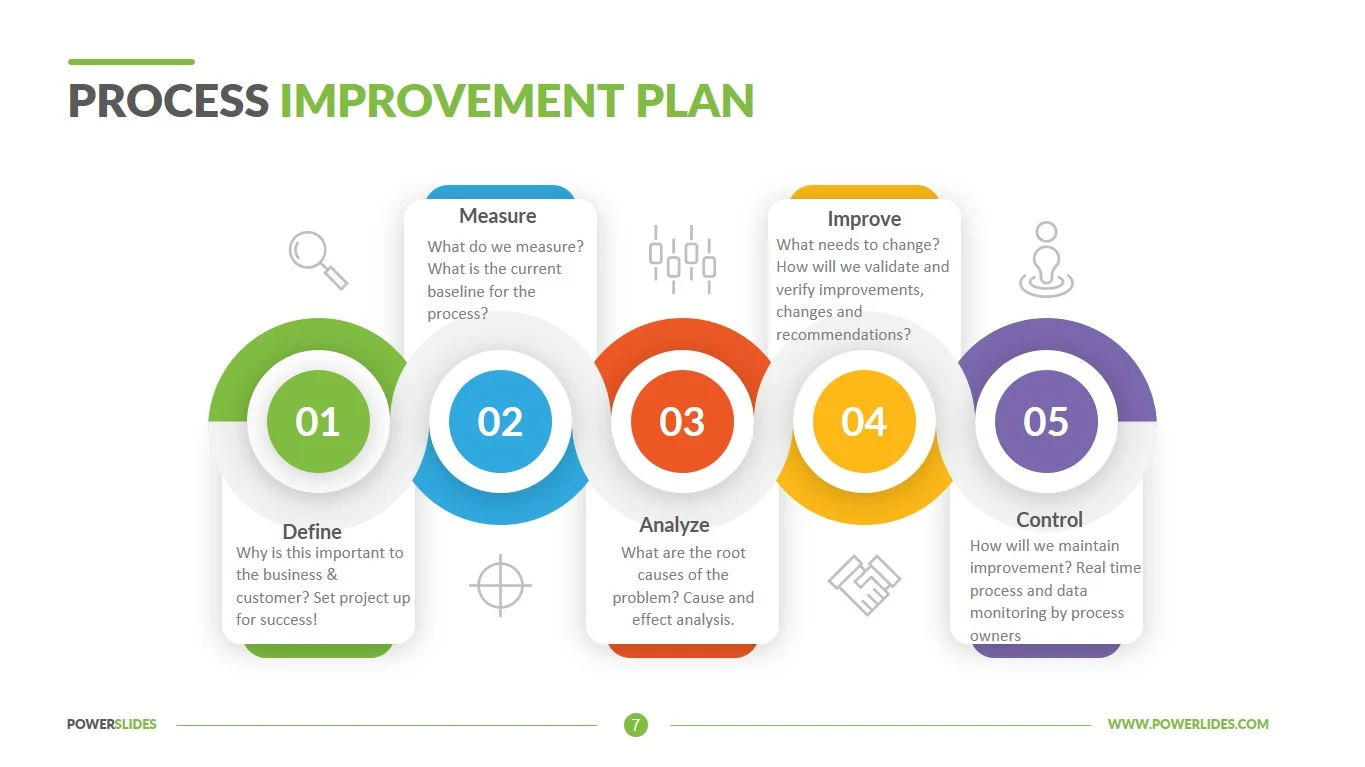
Process improvement plans provide key background information and data regarding the processes that are currently in place. Along with the team’s current performance metrics, the document will also explain why a procedural change is necessary at the present moment.
From there, the document will define the goals of the initiative and the solution to be implemented — followed by an in-depth plan for said implementation. The plan can also include a schedule for implementation and a method for monitoring progress, as well as any supporting documentation to help further your team’s efforts.
Process improvement plans are integral parts of both business process improvement and business process re-engineering . No matter the process in focus, your process improvement plan should act as a roadmap guiding you toward your goals — and bringing you one step closer to procedural optimization.
Why a Formal Process Improvement Plan is Crucial
While some organizations may take an ad-hoc approach to improving processes at times, taking the time to create a formal process improvement plan will always be better for your business. For one, it allows you to gain a more comprehensive and cohesive understanding of the issue at hand. This will help you identify the root cause of the issue, instead of focusing on just one of many symptoms of the problem. (Without taking this step back, you’ll likely end up making mere surface-level changes that don’t actually address the full extent of the issue — which will inevitably lead to even more problems somewhere down the line.) Creating formal process improvement plans also allows you to better prioritize your efforts by focusing on the processes that have the most impact on your business. That way, you don’t end up investing too much time and money making changes that don’t really move the needle for the company. On that same token, creating a strategic plan for improving a given process ensures you’ll be as efficient and cost-effective as possible when doing so. In contrast, a haphazard approach to process improvement will likely require at least some guesswork, trial-and-error, and other rather inefficient approaches. Finally, a formal process improvement plan helps to establish accountability for improvement initiatives. By clearly defining the objectives, responsibilities, and timelines for improvement, a formal plan ensures that everyone in the organization is on the same page and working towards a common goal. (This is crucial not just for immediate, practical purposes, but also to continue fostering a culture of ongoing learning, growth, and engagement throughout your organization.) No matter how simple a procedural change may seem, there’s just too much at stake to not take a formal approach to improving it. Take the time to make a plan of attack; it will always be worth it.
Process Improvement Plan Methodologies
There are a number of methodologies you might choose to follow when developing your process improvement plans. Some key examples include:
- Lean Methodology aims to identify and eliminate wasteful tasks and use of resources throughout a given process. The goal is to make processes as streamlined as possible, while using the absolute minimum amount of resources necessary.
- Six Sigma Methodology focuses on improving quality and reducing defects by eliminating sources of variation throughout a process. The steps involved in Six Sigma methodology are Define, Measure, Analyze, Improve, Control.
- Plan-Do-Study-Act (PDSA) Methodology is a cyclical model of continuous improvement that can be implemented in most operational contexts. As the name suggests, it’s a four-step process of planning, making iterative changes, reflecting on results, and codifying the change within your workflow documentation .
For a more in-depth look at these and other PIP methodologies, check out our article on improving internal business processes .
Effective Process Improvement Plans: Best Practices
Before getting into the step-by-step process of creating an improvement plan, let’s go over some key best practices to follow at all times when creating them.
Align with Your Business Goals
Above all else, you need to be certain that the changes you make align with your business goals — and that they have a substantial and positive impact on your company as a whole. Put another way, you don’t want to make any changes to your processes that will pull your company off-track in any way. While the importance of financial growth is obvious enough, you also need to consider how a change may impact your company culture, employee engagement, or customer loyalty. Keeping this alignment top-of-mind will actually help you maintain a strategic approach to process improvement (as opposed to making a “quick fix” in the heat of the moment — which typically won’t work out for the best). Essentially, you should always be thinking of the “bigger picture”. Before making any systemic changes to your processes, make sure the change you make is the move that will bring you closer to your goals than ever before.
Be Specific
Specificity is vital when planning to make procedural improvements — and when documenting said plan in writing. Firstly, you must be as specific as possible when identifying the process to be improved. This will help you pinpoint the exact thing that needs to change, and will guarantee that you’re focused on the root cause of the problem. (In contrast, being too broad here may cause you to make sweeping changes that are ineffective, superfluous, or both.) You’ll also need to be specific when defining how you’ll make the planned improvement. This is key to remaining lean while also investing the manpower and resources needed to succeed. Finally, you’ll need to define your intended goals and outcomes — and the rationale behind them — clearly and specifically. As we’ll discuss, this will keep you focused on the right tasks throughout the initiative, and also help you assess your efforts once the new process is in place.
Be Data-Driven, Objective, & Critical
The most effective process improvement plans are those that are backed by hard data, allowing teams to take a more objective and critical approach to the initiative. With the right data in hand, there will be very little question as to what process needs to be improved — and how so. Moreover, analyzing comprehensive data sets can help you uncover hidden problems your team may not have been aware of. Becoming more data-driven is key to removing biases during the planning stage and minimizing resistance to change once the plan is in place. Without clear evidence that a given change will improve operations, teams can easily backslide into the “old way of doing things” — in spite of all the frustration the old way may cause.
Involve All Stakeholders
Making even the slightest changes to your processes can impact a number of individuals, both within your organization and outside of it. Involving these stakeholders in process improvement planning, then, is essential. You’ll of course want to involve those who are directly impacted by the change — that is, those responsible for carrying out the process in question. These individuals will have hands-on knowledge of what needs to improve, and will likely have a number of practical solutions in mind for the team to consider. Managers and team leads will have a clear understanding of the team’s capacity for making a change, along with the impact said change will have on the team’s overall operations. When needed, executives can step in to ensure a process improvement plan aligns with the company’s business goals and overall vision for the future. Finally, consult any third-party entity that will be impacted by the change, such as your suppliers, your vendors, or your customers. This will at least help you stay transparent and maintain open lines of communication — and it can potentially lead to major breakthroughs that wouldn’t have happened had you kept everything in-house.
Steps to Creating an Effective Process Improvement Plan
As we’ve said, developing an effective process improvement plan can be a rather involved initiative. Involved — but very much worthwhile. So, without further ado: The eight steps to creating an effective process improvement plan.
1. Define the Process to Improve
Your first order of business is to identify the specific process or workflow to be improved upon.
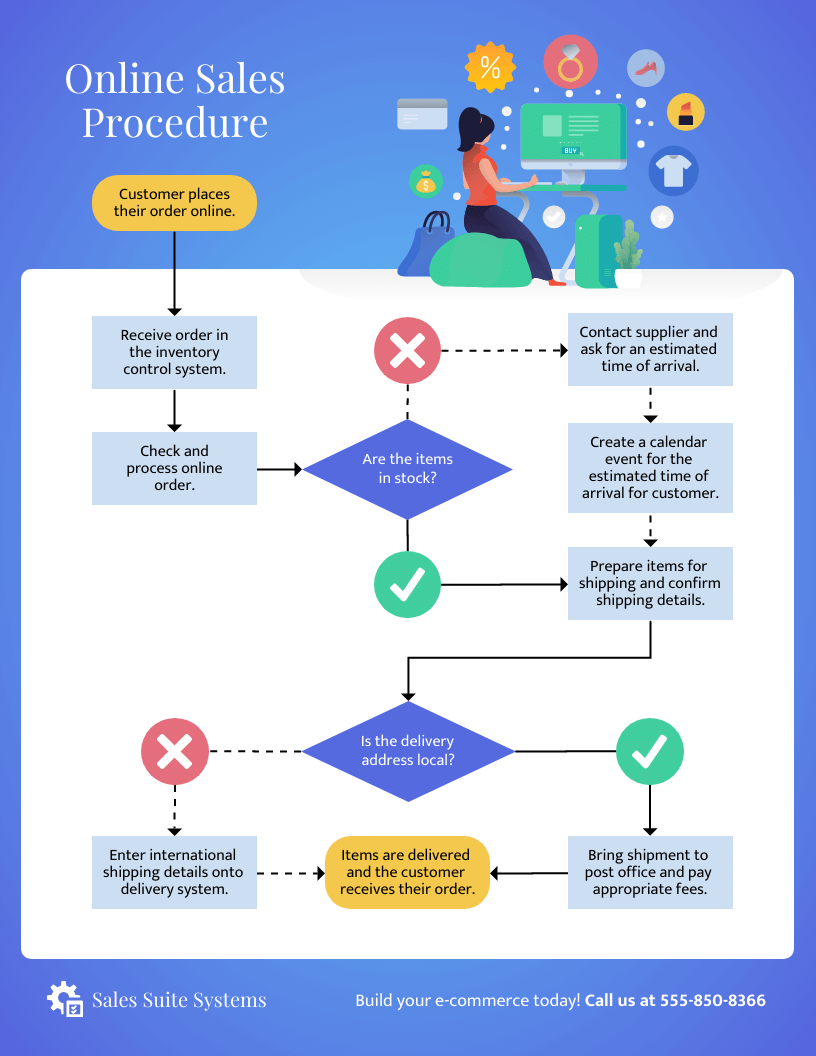
Some key examples:
- Customer service request intake
- Marketing-to-sales lead handoffs
- New hire form submission
Be sure to include any documentation that will help map the parameters of the process . In some cases, it may be necessary to define what the process doesn’t involve to avoid making unnecessary changes. While you’ll eventually provide more details regarding the initiative, you can set the stage here by giving an overview of what’s to be improved, why doing so is important, and what your intended goals are. With a clear vision of success in place, your team can focus on making the specific changes needed to make it a reality.
2. Identify Stakeholders (and Their Roles)
As we said, all stakeholders should be involved in the improvement process to at least a certain degree. For each initiative, you’ll need to define who these entities are, and the role they’ll play in improving the process in question. Again, the main roles to consider include:
- The ground-level employees who will be directly impacted by the change
- Managers and team leads who will spearhead the initiative and facilitate procedural change
- Executives who will oversee the business end of the initiative
- Third-party entities who will be impacted by the shift in procedure
Once you identify these entities, you might consider forming a committee with representatives from each group to help move the initiative forward. This will lead to more and better insights and idea generation during the planning phase — and will allow you to stay transparent as you implement improvements to your processes.
3. Analyze the Current Process
At this point, you can start taking a closer look at the actual process to be improved. As things stand, you want to be clear on what’s working well within the process — and what isn’t. Consider:
- Where do bottlenecks tend to occur?
- Where is resource usage and waste highest?
- Where are members of your team typically left idle or waiting?
Once you identify these troublesome spots, go a step further by looking both up- and downstream. In looking upstream, you may potentially uncover a more systemic issue that is the true cause of the problem you’re facing (and many others!). Looking downstream will allow you to see what other processes will be impacted by a given change — and may open the door for more improvements to be made in the future. When conducting this analysis, remember to use both your collected data and your stakeholders’ collective "know-how" knowledge to form an accurate picture of what the process looks like at the present moment — and how you can improve it moving forward.
4. Create a SMART Goal
Based on your analysis of the process and your current situation, you can create a goal for your initiative that is Specific, Measurable, Attainable, Relevant, and Time-Bound . Going back to the examples mentioned earlier, you might set the following goals for each respective initiative:
- Reduce customer service intake time by 25% within six months
- Improve MQL conversions by 10% this month
- Reduce hands-on touchpoints during employee form submission by 50% this year
This step is crucial to ensure the improvement you make actually impacts your operations in a positive way — and to give your team a clear idea of what successful implementation of the improvement will look like.
5. Brainstorm and Define Optimal Solution(s)
The next step is to brainstorm solutions to the problem as you begin developing the new process. As you brainstorm these ideas, you’ll want to pay attention to the following three factors:
- Feasibility and Practicality : Do you have the manpower to implement the change? Does your team possess the skills and knowledge needed to make the new process work?
- Impact : How will the change impact your stakeholders and your business operations? Will additional changes be necessary once the proposed solution is in place?
- Cost : What will it cost (in money, time, and other resources) to implement the new workflow? When will your organization begin reaping the benefits?
6. Create an Action Plan
Once you define the process to be improved, you can start planning how you’ll actually go about implementing the change within your operations. This can involve a wide variety of steps based on the change to be made. If automating and optimizing the customer service intake process, for example, you’d need to:
- Install and integrate your helpdesk software of choice — and phase out the old solution
- Onboard and train your customer service representatives
- Introduce your new automated solution to your customers
…and much more. Detail is important here, as you want to introduce the change as seamlessly as possible — and ensure that it’s the best decision to make from a business standpoint. To this end, you might choose to create a fleshed out business requirements document to go along with your process improvement plan.
7. Implement, Monitor, & Adjust
As you introduce the new process and it starts to become the “new normal”, you’ll want to keep a close eye on how everything’s going. This should be a team effort involving all stakeholders. While performance metrics and other quantitative data will be a huge piece of the puzzle, you also want to collect more qualitative feedback from those most impacted by the change. (This is especially true when it directly impacts your customers.) From there, you can make adjustments to the process as needed over time — as you should always be doing within all areas of your operations in the first place! In all seriousness, you likely won’t need to create an entirely new process improvement plan as you make these slight adjustments. But, if the “new way” doesn’t pan out the way you’d hoped, there’s no shame in going back to the drawing board.
8. Document, Document, Document
At this point, you’ll have likely documented the new process in text and graphic formats. Now, you’ll want to start creating additional knowledge documentation that:
- Explains procedural steps in full detail
- Demonstrates the process in action (via video content)
- Provides expert tips and best practices to optimize the process
Zooming out a bit, be sure to adjust any documentation regarding your overarching approach to process improvement planning. On top of making the new process “official”, documenting it also makes the information more accessible. Marco Armineta, Director of Customer Experience at Valant , explains that documenting new processes with Helpjuice enabled his team “to quickly rollout initiatives that proved difficult with our previous solution, including the ability for customers to rate content and provide free-text feedback.”
Use Helpjuice to Empower Your Process Improvement Plans
Helpjuice’s knowledge base software can supercharge your efforts to improve internal operations at every step of the process. Brainstorm solutions and create plans for improving processes in real-time with collaborative documentation Document and share new workflows with employees and other stakeholders in seconds Make continuous improvements to process and workflow documentation over time Ready to get started? Sign up for a free 14-day trial of Helpjuice today!
More Blog Posts
Enjoyed this article? Check out our favorites

5 Simple Steps to Increase Customer Lifetime Value (+16 Examples)
The Ultimate Guide to Creating a Customer-Centric Strategy for Your Business
Comprehensive Guide to Knowledge Hoarding in 2024
Case Studies

Our Case Studies
Some of the best case studies to improve your knowledge base
.jpeg)
How One Tool Slashed Vivery's Setup Time by 87% and Saved Thousands in Labor...

From Support Tickets to Satisfaction: The Incredible Transformation at Sign ...

Discover the Secret to Obbi's 30% Decrease in Support Tickets!...
Start your 14-day free trial.
Join over 1000+ companies already growing with Helpjuice.
- Contact sales
Start free trial
How to Make a Process Improvement Plan (Free Template)

Project management is made up of processes. Project managers and their teams depend on those processes to ensure that a project runs smoothly. But what about those processes? Are they chiseled in stone or can they be improved?
Too often processes are relied on as if they were somehow perfect and cannot be touched. That type of thinking is what will quickly send a project off track and possibly cause it to fail.
Complacency has no place in project management. Constantly analyzing your processes is the best way to reach a successful end. How you improve processes is through a technique called process improvement. Implementing what you learn through process improvement is done by creating a process improvement plan.
What Is a Process Improvement Plan?
Simply put, a process improvement plan is a document outlining how to improve your business processes after identifying and analyzing them. In a nutshell it’s how can you get better at what you do. The process improvement plan is part of a larger, overall strategic plan of an organization. It guides businesses on how to analyze its various business processes and outlines where there’s room for measurable improvements.

Get your free
Process Improvement Plan Template
Use this free Process Improvement Plan Template for Word to manage your projects better.
The point of a process improvement plan is to find weak links in the process chain or bottlenecks that are impeding work, and then figure out ways to rectify those inefficiencies. This leads to processes being completed faster, more efficiently and with a greater quality of deliverables.
A process improvement plan is an important business process management tool that will also help to reduce wasted efforts and keep teams working more productively. It helps to reduce any friction that exists in the processes, and ensures processes meet regulatory compliance standards when required.
ProjectManager has planning, scheduling and tracking tools that allow organizations to manage their projects and business processes. Use Gantt charts, timesheets, real-time dashboards among many other features to make project timelines, estimate costs, make budgets, allocate resources and much more. Get started with ProjectManager today for free.
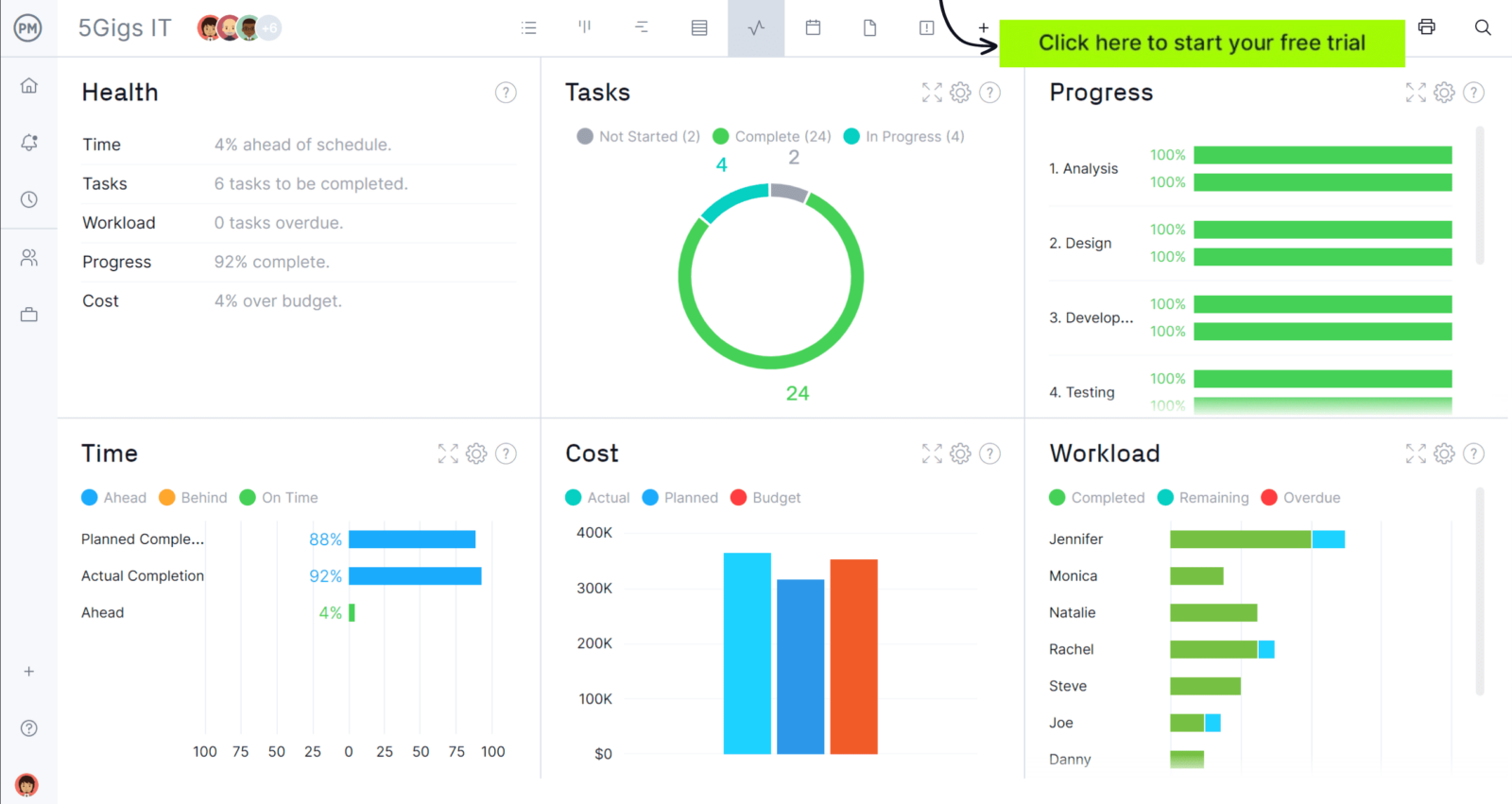
Process Improvement Plan Example
Here’s a simple process improvement plan example to better understand what its contents are and how it works.
Imagine a manufacturer that intends to improve its production process to make it more efficient. This manufacturer makes wooden doors for construction projects , which means it generally works on production orders for multiple clients simultaneously so it needs to manufacture its products faster to be able to take on more projects.
Business Process Map
The process of manufacturing a door is shown in the business process map below. This process consists of four steps; cutting the wood, sanding, painting and finally assembling the doorknobs, hinges and other pieces. From there, the finished units are transferred to the warehouse and prepared for shipping. If work in progress doesn’t pass the inspection after one production process has been performed, it needs to go back and be redone, as shown by this workflow diagram arrows.

Bottlenecks & Issues
After mapping the steps of this business process, the manufacturer can now begin identifying the bottlenecks, issues and other areas of improvement. Here are some of their findings:
Bottlenecks
Inspecting work in progress after each of the production steps takes the most time out of any other activity in this process because there are not enough production quality inspectors. This issue halts production when working with large production volumes or when manufacturing production orders for multiple clients.
- The painting step has the highest error rate of these activities because it relies almost exclusively on manual labor.
- Cutting machines are becoming old, malfunctioning and breaking down more frequently. This not only halts the production process , but causes defective
- products which increases costs and affects the profitability of a manufacturing contract.
- The shop floor layout and production routing of this manufacturer isn’t efficient because it has pieces of machinery too far apart from each other, so employees need to physically transport raw materials throughout the production floor, which takes time and effort and lowers productivity.
Process Redesign
Here are the improvement strategies that have been developed for each of the bottlenecks and issues described above.
- Hiring an external consulting firm to audit the inspection processes, standardize them and make them faster.
- Hiring additional production quality inspectors.
- Purchasing machinery to significantly reduce or eliminate the use of human labor in the painting process.
- Then reassign these production workers to other activities, such as cutting and sanding. This will improve the production capacity of the organization.
- Purchasing new cutting machinery to reduce defect density, production downtime, scrap rate and increase productivity.
- Audit the shop floor plan and reorganize it to make it easier for work-in-progress materials to flow around the production line faster and require less effort from production workers.
Process Improvement Team
These individuals will be responsible for making the process improvement plan and implementing the changes to the business process.
- Production management consultant: The manufacturer will hire an external production management consultant who will be asked to come up with a new inspection standard operating procedure for each of the steps in the production process. The main objective is to make inspection faster while maintaining the company’s high standards.
- Production workers: In this process improvement plan example, production workers are the best source of information regarding bottlenecks and issues in a workflow as they experience them on a regular basis. They will ultimately implement any changes and improvement strategies so it’s important to communicate to them what their new role is and what’s expected from them.
- Production quality inspector: This is a critical role in this process improvement plan example as they are the solution for speeding up the inspection process, which is currently the most significant bottleneck. Fixing this means the manufacturer will be able to make products much faster, take on more projects at a time, scale and grow its revenue.
- Production managers: The production manager is responsible for overseeing the production process as a whole and acting as a liaison between the other members of the process improvement team.
Implementation Plan
Now that the issues, solutions and the people who will execute the work have been defined, it’s time to define the action steps that will be taken to execute this process improvement plan.
- Hiring a production management consultant to improve the inspection procedures
- Training the production quality inspectors and production managers team on new inspection guidelines and standard operating procedures
- Purchasing new cutting and painting machinery
- Reassigning painting employees to new positions
- Training employees on their new roles and the correct use of new production equipment
This implementation plan should also include a timeline, which can be created using a Gantt chart . Here’s what this timeline looks like in ProjectManager’s Gantt chart.

A process improvement plan should also define what resources will be required and what their costs are. Then all these costs are added to make a budget. This allows organizations to determine whether a process improvement plan is feasible from a financial perspective. ProjectManager’s Gantt chart also helps you keep track of the costs of all the tasks of the process improvement plan.
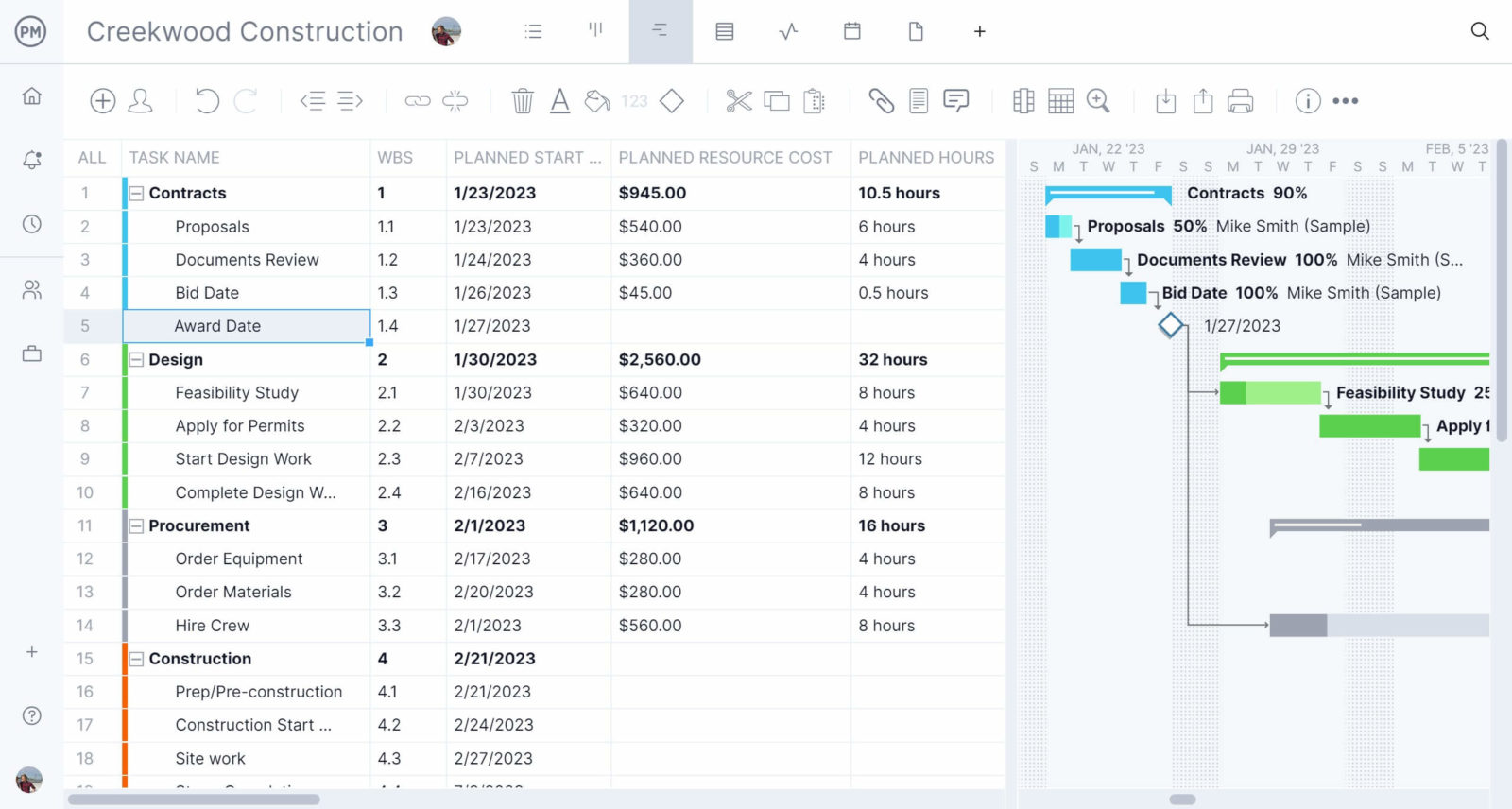
This process improvement plan template helps you gather the key information that your organization will need to improve its business processes.

Build a Process Improvement Plan in 7 Steps
To do the work of identifying the weak points in a process and do nothing about it is counterproductive. It might feel like the effort of creating and implementing a plan is not worth the investment.
But if you believe that there are flaws in your process and you don’t respond to improve them, you’re setting yourself up for a bigger problem down the line. Therefore, it’s always in your interest to respond to the problem and work towards resolving it. To do this requires a plan. The process improvement plan can be broken down into these seven steps.
The first step is to get a full overview of the process that needs improvements. Take that process and break it down into a map. You can use a free work breakdown structure from ProjectManager to thoroughly map every step of the process. This will help you get an idea of where the weaknesses are in the process.
Now that you have the process in question mapped out and every step delineated, you need to analyze the process to see where the issues might lie. Look closely at each of the steps and see where there was a problem, such as delays, over-allocation of resources, too much money spent, idle team members and so on.
Once you’ve found those problem spots, trace back the issue to its origin to address its cause and how to avoid it in the future. You can use tools, such as the root cause analysis method to help guide you.
3. Redesign
Once the cause of the problem has been uncovered, it’s time to redesign the process to improve it and avoid the issue when next using it. At this point, you’ll want to bring in the whole project team.
They are, after all, the ones who have the most intimate knowledge of the process and hands-on experience with it. They’ll make sure there are no stones left unturned and everything has been documented in the process. They’re an invaluable resource for process improvement and should be listened to.
Get their ideas on how to redesign the process and brainstorm with them for more solutions. Then analyze all the solutions offered and figure out which one is the best and most likely to improve the process. Now you’ll want to think about the schedule and whatever risks might be inherent in the redesign.
You’ve identified the problem and have a solution, now you need to get working on it. That means assigning your resources. The go-to people would be the team members who are impacted by this process and its change. However, you might need to reach out beyond that sphere to other people in the organization with the skill sets required.
Once you’ve assembled a team, give them detailed instructions on how to redesign the process and why it’s important. You can use the map you created earlier in the plan to help with this step.
5. Implementation
This is where the process improvement plan is put into action, which means creating a detailed task list and assignments. This part of the process is just as you would create any project plan, breaking down the deliverables into tasks and assigning each team member with those tasks. Project planning software can help.
You’ll want to create a schedule with a timeline and add tasks, their duration, and any dependencies.
6. Communication
The better your communication, the better the project. Therefore, take the time to communicate your plan to the team and make sure they fully understand their part. Listen, be open to feedback, and make sure the team understands that they’re going to be kept in the loop throughout the whole process. This creates buy-in and helps them embrace the new process.
Once the team is executing the project, it’s important to track their progress. Monitoring is not micromanaging. It provides a window into the project and allows for any tweaks to keep it moving as scheduled.
Also, once the improvement has been implemented into the process, you have to monitor the team to make sure that they’re following it. As problems arise, the process starts again.
ProjectManager Manages Process Improvement Plans
A process improvement plan is no different than any other project plan. It requires planning, scheduling, assigning teams and tracking their progress. ProjectManager is online project management software that can do all of this and more.
Manage Tasks & Build Timelines
Once you have a process that needs improving and have a plan and team ready to execute that plan, ProjectManager comes in with the controls you need to keep the plan running smoothly. First, you can upload your task list into the software and create a project.
Once the tasks are given a duration, they show up on a Gantt chart timeline . Now you can link the dependent tasks to prevent bottlenecks. If there are changes, ProjectManager makes it easy to edit the schedule. Just drag and drop the task start and end dates.
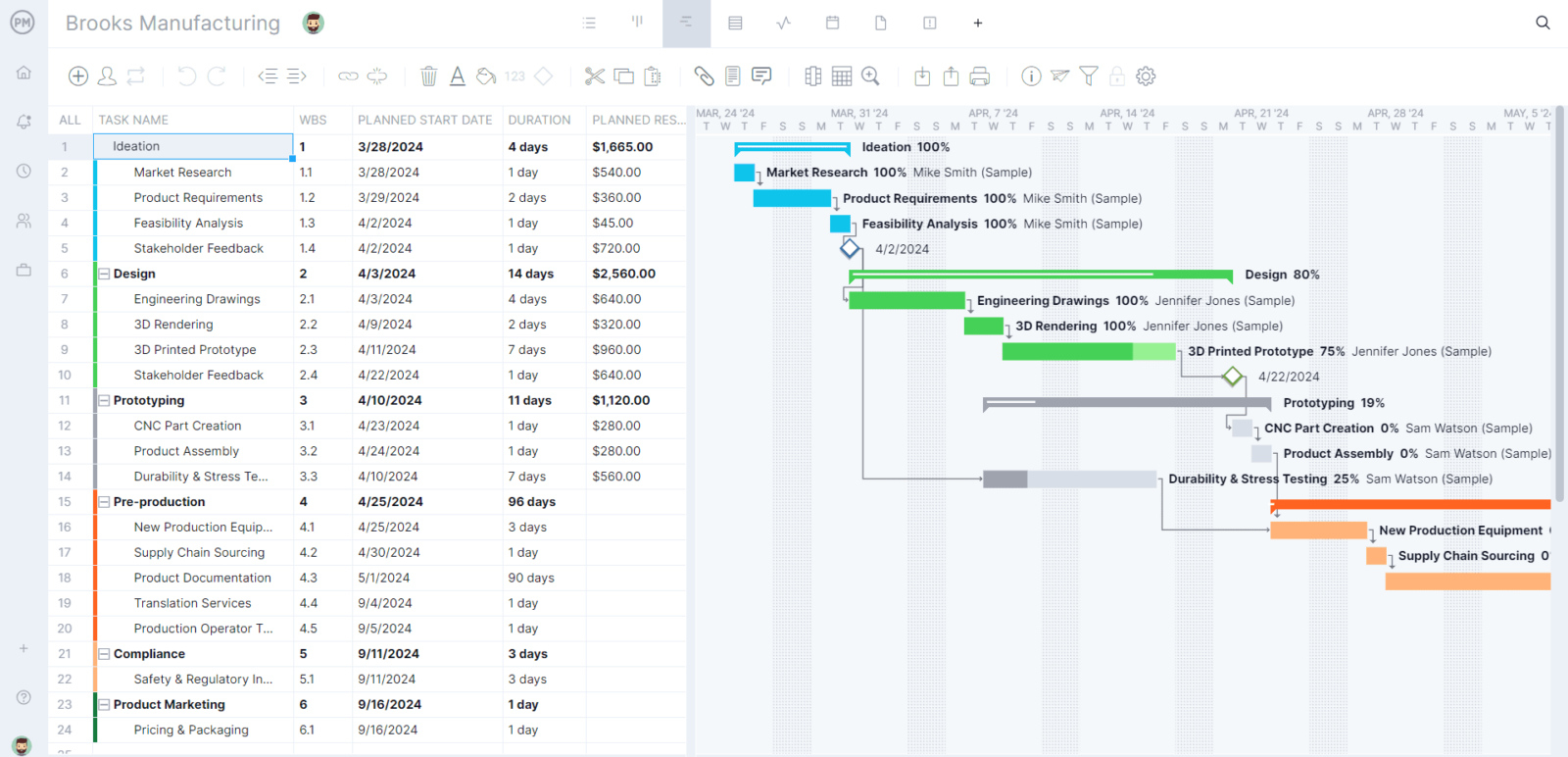
Team Members Can Manage Their Work & Collaborate
Team members can be assigned from the Gantt chart project view, but they also have the option of managing their tasks with a task list, calendar or kanban view. Each task can have detailed directions from the project manager and even documents and images attached as needed.
Team members can then collaborate at the task level, commenting, adding files and even bringing in other team members by tagging them. They’re then notified by email and can join the conversation. Because ProjectManager is cloud-based, remote teams can collaborate wherever they are, and at any time.
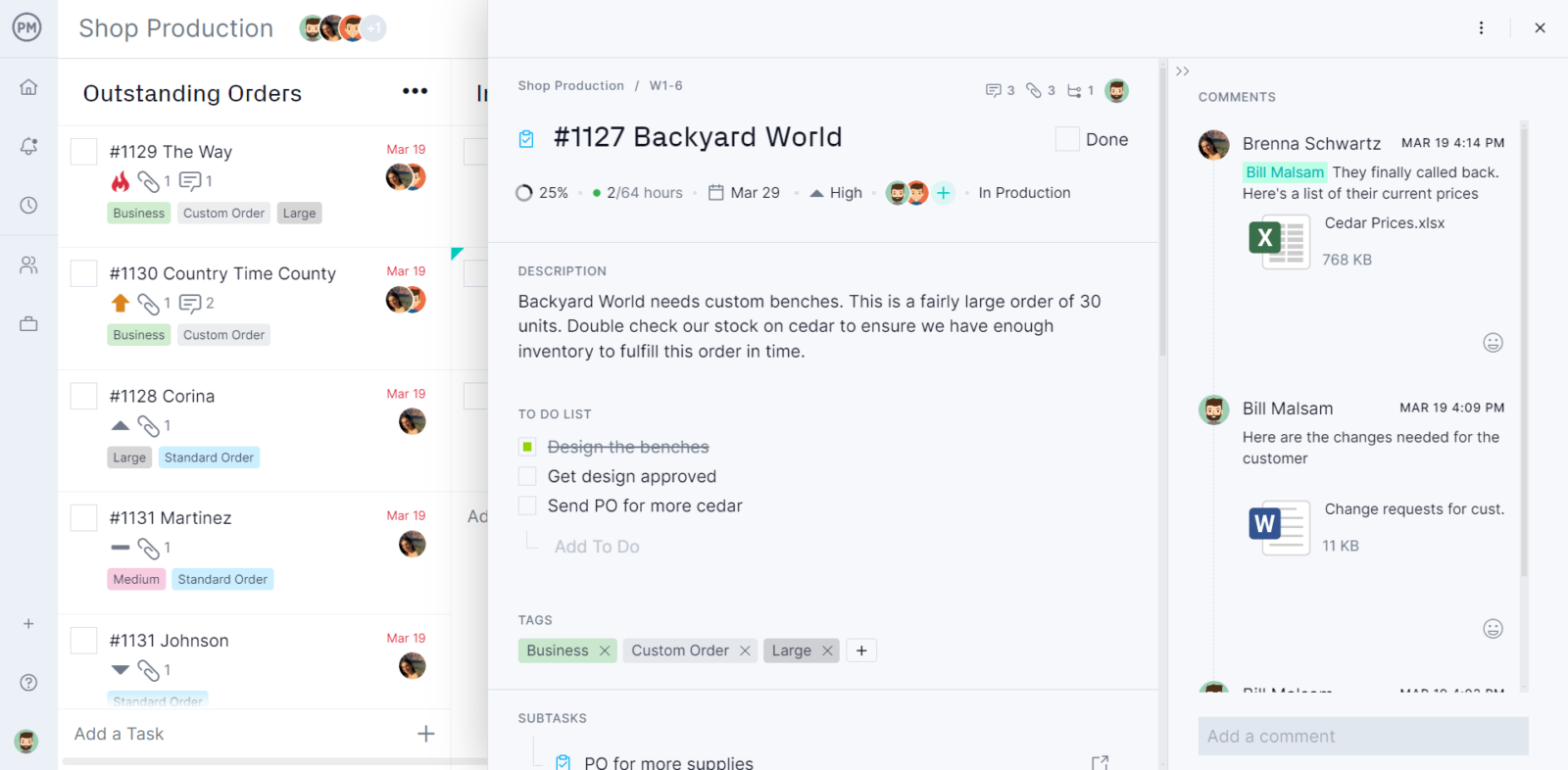
Track Progress as It Happens
Project managers can use the dashboard to monitor six project metrics at a high-level view, all in real time. For a more detailed view, ProjectManager has one-click reports that can be filtered to show exactly the information you want. Reports are great for tracking the project and reporting back to stakeholders, so they’re always in the loop.
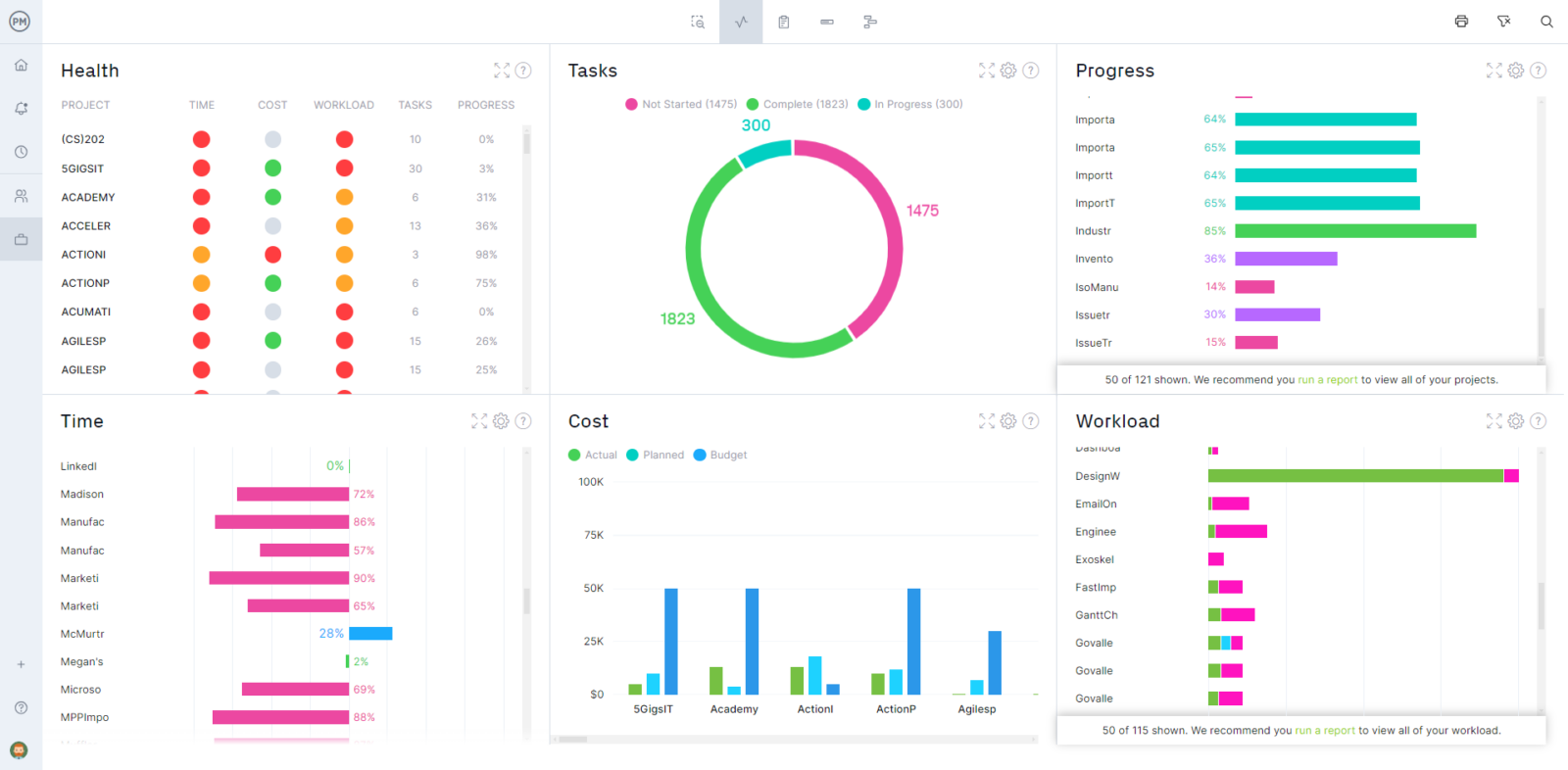
ProjectManager gives you the tools you need to improve any process. From making a process improvement plan to executing that plan and monitoring its progress, ProjectManager has features like Gantt charts and kanban boards, all made to foster team collaboration and productivity. Use ProjectManager for your next process improvement plan by taking advantage of our free 30-day trial today.

Deliver your projects on time and on budget
Start planning your projects.

IMAGES
VIDEO